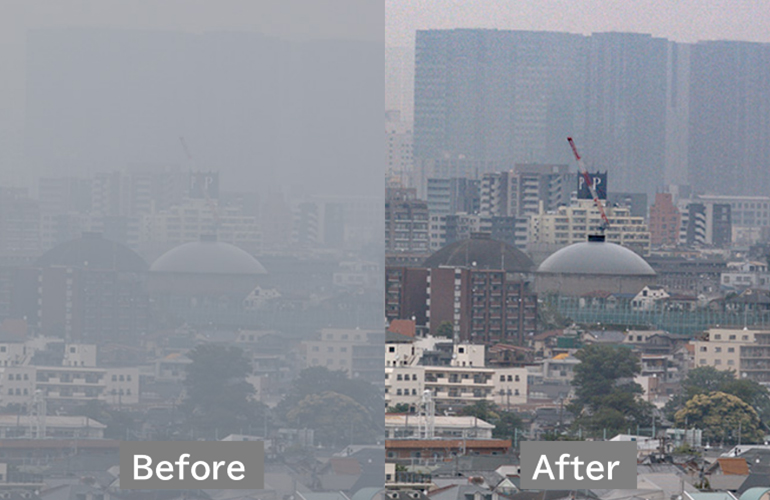What are technologies that create value from images and videos?
Technologies that create value from images and videos are Canon’s proprietary technologies that convert and optimize digital signals created by sensors for a specific purpose of use. These technologies boost the added value of our cameras, printers, medical equipment, and other imaging devices.
These technologies include image quality quantification technology that captures numerically aspects of image and video quality — such as hues, clarity, and noise, which were previously judged by human intuition — and measures whether the image data faithfully reproduces what is seen. Other examples are image sharpening technology that improves the quality of image data and thereby increases the value of the image itself; and image recognition technology that analyzes features in image data to accurately recognize and extract text information or information that identifies a person. A further example is the application of standardization technologies which enables the bidirectional transfer of information between many different devices and services worldwide. Using the right combination of these technologies for the application helps improve product performance and boost its added value.

Advantages of Canon’s technologies that create value from images and videos
Advantages of Canon’s technologies that create value from images and videos are reproducing colors faithfully and consistently as perceived by human eyes without relying on human perception or experiences; recreating images more clearly than the human eye can see; and extracting information from images. Canon has evolved and stockpiled these technologies through our extensive research focused on generating images with more added value, such as color reproducibility and image clarity, during the development of a wide range of products, from input devices such as cameras to output devices such as printers. One key technology is image sharpening technology, which uses the latest in image processing technology to enhance images captured by network cameras and other devices. For example, when shooting surveillance footage at night, from a distance, or in bad weather, increasing the ISO speed* to raise the brightness also results in a lot of noise. To improve image clarity, Canon developed technology that uses deep learning to recognize just the noise component and remove it. The technology produces images with clarity that exceeds human perception, even in conditions people find it hard to see in, which, in turn, aids the safety and security of people.
*ISO speed indicates how sensitive a camera is to the light that reaches it. A higher ISO setting makes the camera more sensitive to light, allowing it to capture brighter images in dark conditions.

Application case study:
Super Color Management technology reproduces the colors that human eye perceives
Image quality quantification technology that measures accurately what people see is essential on the printing frontlines.
Even when printing the same image, differences in printer models and paper types cause color mismatches. As a result, color variations occur when printing the same image on multiple printers. There are international color management standards that manage the colors on printed matter numerically. However, even when the numbers match, the colors we perceive may look different. Canon’s Super Color Management technology, in addition to the physical traits of color that are conventionally measured, looks at how people perceive colors. We developed a scale for measuring colors according to how people perceive them, by taking advantage of our many decades of research into color during the development of our cameras, printers, and other devices. We use this color scale to map colors that have nearly the same visual impressions when viewed. It also analyzes the image to be printed, compares the desired colors with those that the printer can reproduce, and processes the image so it gives nearly the same visual impression after printing. This improvement in color consistency is expected to radically change printing workflows for diverse print jobs involving the use of multiple printers at different locations.

Application case study:
AI image reconstruction technology that enables acquisition of high-resolution images with shorter scan times
One of the advantages of magnetic resonance imaging (MRI) is that it doesn’t involve exposure to ionizing radiation. In MRI, a powerful magnetic field and radio waves are generated in order to visualize organs and blood vessels in the body. However, examinations can take up to 30 minutes because acquiring images for multiple planes within the body requires scanning from various directions. The longer the scan time, the higher the likelihood that the patient will move during the examination, making it more difficult to obtain high-resolution images. One of the longstanding challenges of MRI has been to acquire high-resolution images while shortening scan times.
By applying technologies originally created for CT, Canon has developed Precise IQ Engine (PIQE), a high-resolution imaging technology. In PIQE, images are reconstructed using advanced AI technology, which also reduces noise generated in the high resolution process. While PIQE enables higher resolution images, noise reduction allows acquisition of clearer images of tissues at the same resolution and one-third the scan time of a conventional system.

Related Links
R&D introduction PDF "THE CANON FRONTIER"
Technology


